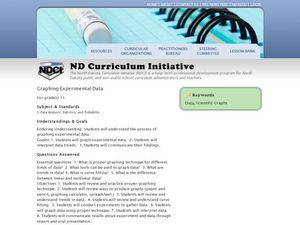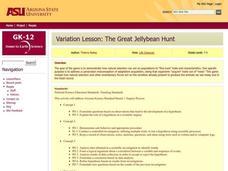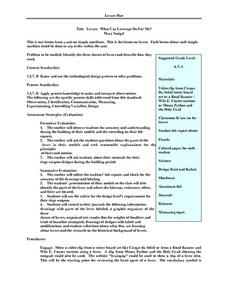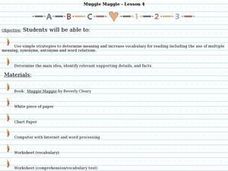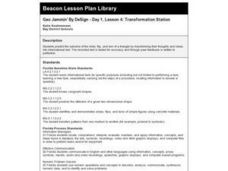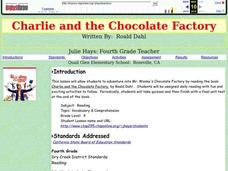Curated OER
The Three Branches of Government
Sixth graders discover details about the 3 branches of government. In this primary source analysis instructional activity, 6th graders examine documents and images from the Library of Congress to investigate the structure of the U.S....
Curated OER
Data and Scientific Graphs
Students conduct experiments and graph their data. In this statistics lesson, students collect data and graph it on a coordinate plane. They analyze the data looking for patterns and they discuss their findings with the class.
Curated OER
Modeling the Big Bang and the Formation of the Universe
Sixth graders conduct an experiment to understand the Big Bang Theory. In this Big Bang Theory instructional activity, 6th graders will observe a balloon with confetti popping to emulate and analyze information related tot he Big...
Curated OER
Estamos en la granja (We are on the farm)
Learners receive a blank farm scene and a baggie of animal cutouts with names on them. They sit back to back so they cannot see each other's farm scene, then place 3-4 animals on their farm scene. They ask each other if their animal is...
Curated OER
Cloze Instruction And Herringbone Technique
Students sort out important information and create a visual framework for reviewing in the future. They organize a large quantity of information thus helping with learning and remembering details, cause and effect, comparison and...
Curated OER
STRAINING FOR SOUND
Sixth graders use a laser along with computer microphone probeware and the appropriate software, 6th graders determine the speed of rotating objects.An audio amplifier is connected to a solar cell to change the laser light signal into a...
Curated OER
The "Ad" Survey-What Makes a Print Ad Convincing?
Young scholars develop opinions from a variety of materials, recognize and analyze bias, propaganda and stereotypes, and evaluate effectiveness of print advertisements.
Curated OER
The Great Jellybean Hunt
Students explore natural selection and its influence on the populations to fine tune traits and characteristics. The acquisition of traits developed out of need is examined through a game played in class.
Curated OER
Levers: What Can Leverage Do For Me?
Students determine the identity of the three classes of levers while explaining how each works. They wait a video clip that shows uses for different types of levers and work as a class to write a KWL chart. Finally, they make a model fo...
Curated OER
Death On Board La Belle: Finding Clues from Old Bones
Students practice analyzing skeletal remains for clues by using the Internet. In this scientific investigation lesson, students research the La Belle shipwreck using the Internet and written materials, later completing a Skeletal...
Curated OER
My Wet Robot
High schoolers design an underwater vehicle. In this engineering lesson, students will design an underwater robot that includes specific systems for it to function properly. Each group will present their prototype to the class.
Curated OER
Student D
Learners are being evaluated on their math skills. In this algebra lesson, students review basic math skills and are being reviewed for leaning skills that may enhance or inhibit their learning skills. They are scored based on a special...
Curated OER
Cold War
Eleventh graders analyze U.S. foreign policy since World War II, tracing origins and geopolitical consequences (foreign and domestic) of the Cold War and containment policy.
Curated OER
Bill of Rights
Learners analyze the U.S. Bill of Rights. They conduct research on an amendment of the Bill of Rights, complete a worksheet that matches scenarios to amendments of the Bill of Rights, and write a letter to their Congressperson.
Curated OER
Shapely Figures
Students are given magazines, scissors, glue, and one sheet of construction paper. They look for pictures showing real life representations of rectangular prisms, spheres, cones, and pyramids. Pupils cut out pictures showing each of...
Curated OER
What's the Matter?
Learners explore the components of matter. They discover what matter is, the states of matter, and how heat and cold cause it to change states in an online format. In addition, they complete internet-based lessons, activities, and quizzes.
Curated OER
For Safety's Sake: Introduction to Laboratory Safety in Science
Students practice safety in and out of the science laboratory. In this science lesson plan, students consider a list of safety precautions and guidelines as they apply to the science laboratory and associate the correct laboratory safety...
Curated OER
Maggie, Maggie
Students read Maggie, Maggie by Beverly Cleary. In this Maggie, Maggie instructional activity students develop strategies for understanding vocabulary in the story. Students survey the number of left and right handed...
Curated OER
Weather, Data, Graphs and Maps
Students collect data on the weather, graph and analyze it. In this algebra instructional activity, students interpret maps and are able to better plan their days based on the weather reading. They make predictions based on the type of...
Curated OER
Designing a Study
Students explore features to consider when designing a scientific study. In this science research lesson plan, students examine different methods of data collection and consider which method would be appropriate for determining how many...
Curated OER
Walk on the Wild Side
Have your class practice alliteration using this lesson. Learners listen to stories with alliterative elements and create their own sentences illustrating this technique. The lesson is incomplete, but could be enhanced to provide a...
Curated OER
Geo Jammin' By DeSign - Day 1, Lesson 4: Transformation Station
Second graders manipulate triangles to discover the concepts of slides, flips and turns of a geometric shape.
Curated OER
Charlie and the Chocolate Factory
Fourth graders read and take quizzes over the book, Charlie and the Chocolate Factory.
Curated OER
The Blue Bottle: An Example of Teacher-Guided Inquiry
Students observe a demonstration in which a bottle containing a colorless solution is mixed, turns blue, then becomes colorless again. They record observations, form and discuss hypotheses, and draw a conclusion based on the evidence.

